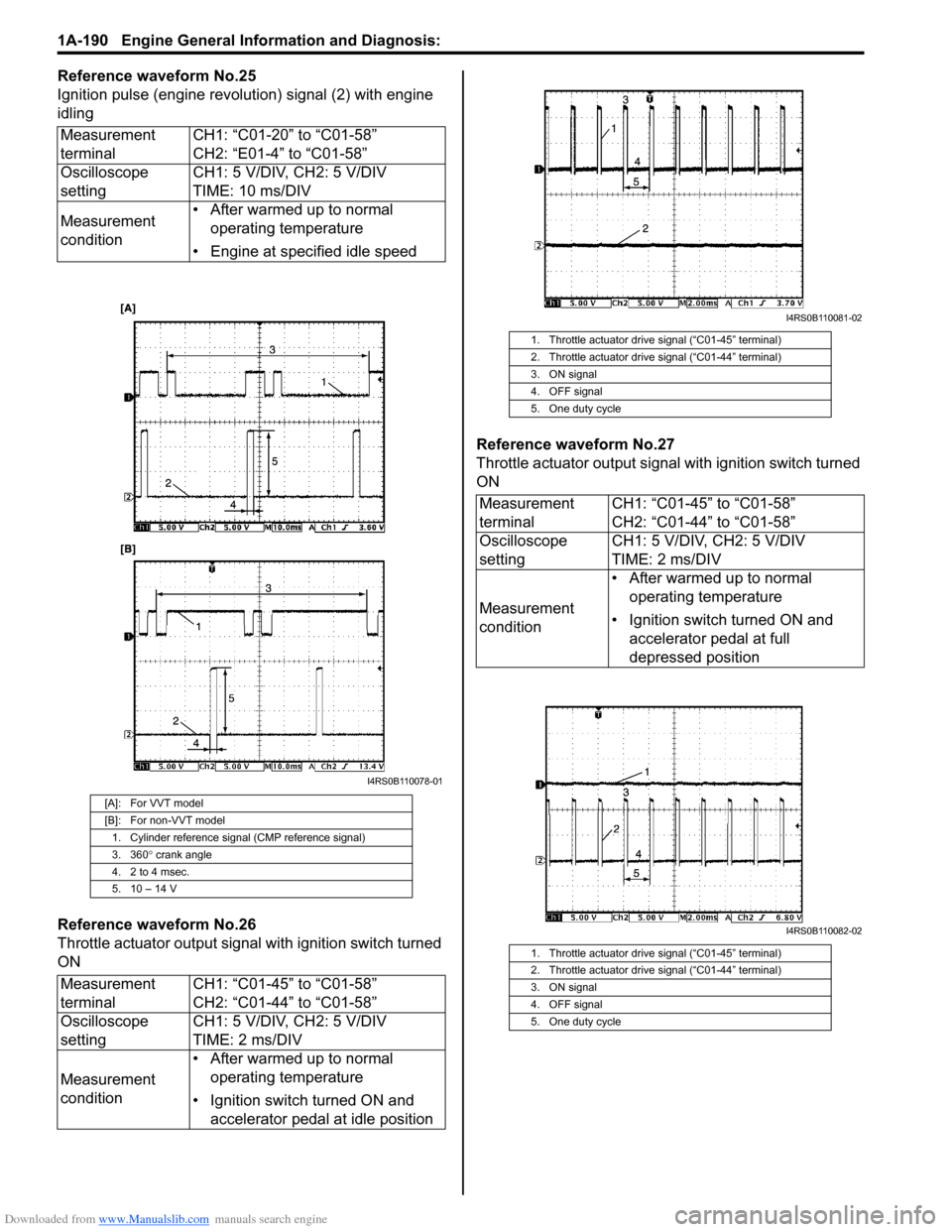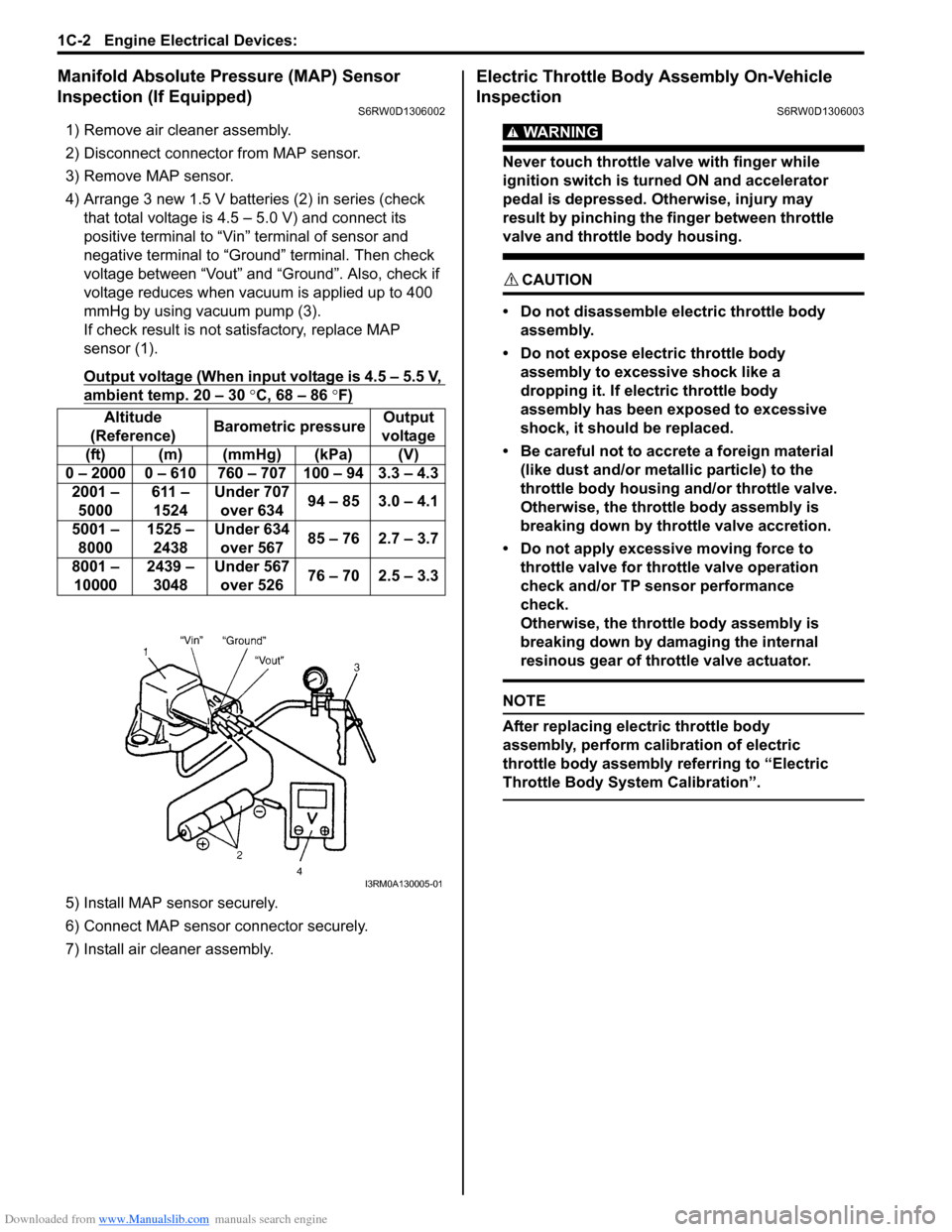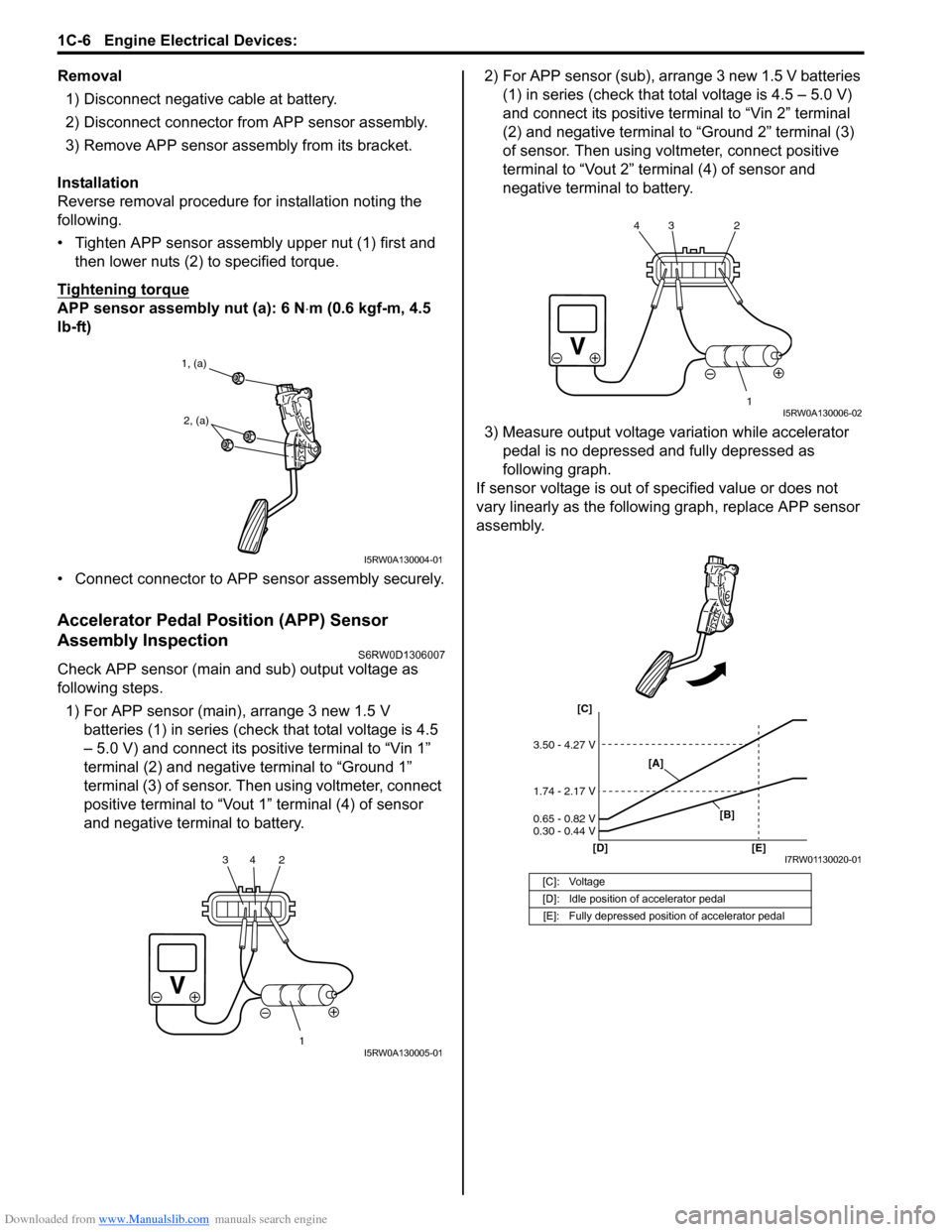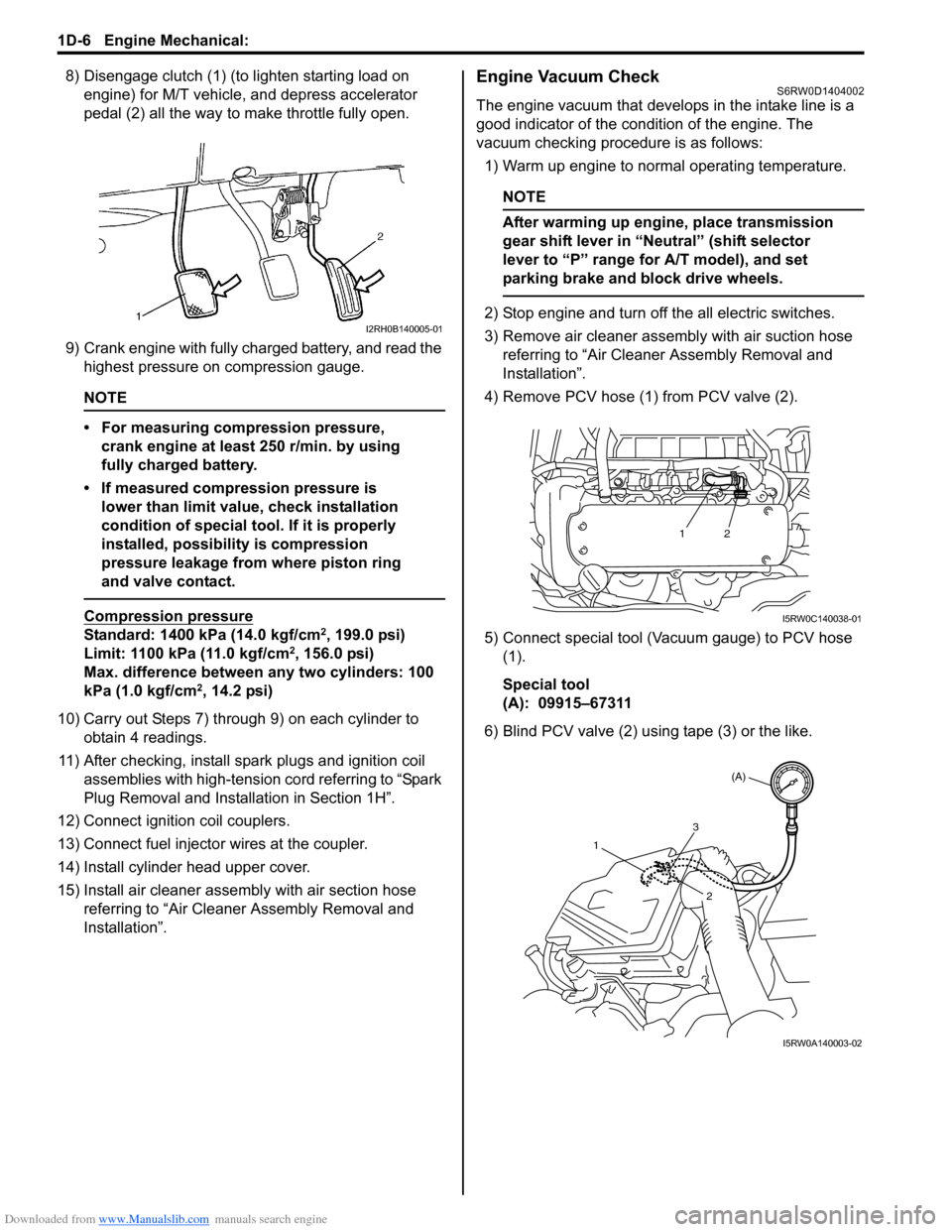accelera SUZUKI SX4 2006 1.G Service Repair Manual
[x] Cancel search | Manufacturer: SUZUKI, Model Year: 2006, Model line: SX4, Model: SUZUKI SX4 2006 1.GPages: 1556, PDF Size: 37.31 MB
Page 238 of 1556

Downloaded from www.Manualslib.com manuals search engine 1A-188 Engine General Information and Diagnosis:
Reference waveform No.19
Knock sensor signal at engine speed 4000 r/min.
Reference waveform No.20
Knock sensor signal at engine speed 4000 r/min.Reference waveform No.21
Oil control valve signal with engine idling (for engine with
VVT system)
Reference waveform No.22
Oil control valve signal with engine racing (for engine
with VVT system) Measurement
terminalCH1: “C01-56” to “C01-58”
Oscilloscope
settingCH1: 1 V/DIV
TIME: 10 ms/DIV
Measurement
condition• After warmed up to normal
operating temperature
• Engine running at 4000 r/min.
Measurement
terminalCH1: “C01-56” to “C01-58”
Oscilloscope
settingCH1: 1 V/DIV
TIME: 200 µs/DIV
Measurement
condition• After warmed up to normal
operating temperature
• Engine running at 4000 r/min.
I4RS0B110072-01
I4RS0B110073-01
Measurement
terminalCH1: “C01-60” to “C01-59”
Oscilloscope
settingCH1: 5 V/DIV
TIME: 2 ms/DIV
Measurement
conditionAt the moment of the ignition switch
turned on
1. ON signal 3. Only duty cycle
2. OFF signal
Measurement
terminalCH1: “C01-60” to “C01-59”
Oscilloscope
settingCH1: 5 V/DIV
TIME: 400 µs/DIV
Measurement
condition• After warmed up to normal
operating temperature
• Vehicle running at 20 km/h (12
mph) and depress accelerator
pedal fully
1. Accelerator pedal depressed fully 4. ON signal
2. Accelerator pedal depressed partially 5. OFF signal
3. Oil control valve signal
I4RS0B110074-01
I4RS0B110075-01
Page 240 of 1556

Downloaded from www.Manualslib.com manuals search engine 1A-190 Engine General Information and Diagnosis:
Reference waveform No.25
Ignition pulse (engine revolution) signal (2) with engine
idling
Reference waveform No.26
Throttle actuator output signal with ignition switch turned
ONReference waveform No.27
Throttle actuator output signal with ignition switch turned
ON Measurement
terminalCH1: “C01-20” to “C01-58”
CH2: “E01-4” to “C01-58”
Oscilloscope
settingCH1: 5 V/DIV, CH2: 5 V/DIV
TIME: 10 ms/DIV
Measurement
condition• After warmed up to normal
operating temperature
• Engine at specified idle speed
[A]: For VVT model
[B]: For non-VVT model
1. Cylinder reference signal (CMP reference signal)
3. 360° crank angle
4. 2 to 4 msec.
5. 10 – 14 V
Measurement
terminalCH1: “C01-45” to “C01-58”
CH2: “C01-44” to “C01-58”
Oscilloscope
settingCH1: 5 V/DIV, CH2: 5 V/DIV
TIME: 2 ms/DIV
Measurement
condition• After warmed up to normal
operating temperature
• Ignition switch turned ON and
accelerator pedal at idle position
I4RS0B110078-01
1. Throttle actuator drive signal (“C01-45” terminal)
2. Throttle actuator drive signal (“C01-44” terminal)
3. ON signal
4. OFF signal
5. One duty cycle
Measurement
terminalCH1: “C01-45” to “C01-58”
CH2: “C01-44” to “C01-58”
Oscilloscope
settingCH1: 5 V/DIV, CH2: 5 V/DIV
TIME: 2 ms/DIV
Measurement
condition• After warmed up to normal
operating temperature
• Ignition switch turned ON and
accelerator pedal at full
depressed position
1. Throttle actuator drive signal (“C01-45” terminal)
2. Throttle actuator drive signal (“C01-44” terminal)
3. ON signal
4. OFF signal
5. One duty cycle
I4RS0B110081-02
I4RS0B110082-02
Page 241 of 1556

Downloaded from www.Manualslib.com manuals search engine Engine General Information and Diagnosis: 1A-191
Reference waveform No.28
Ignition coil signal and fuel injector signal with engine
crankingReference waveform No.29
Throttle position sensor main (1) and sub (2) signal
Reference waveform No.30
Pedal position sensor main (1) and sub (2) signal Measurement
terminalCH1: “C01-20” to “C01-58”
CH2: “C01-6” to “C01-58”
CH3: “C01-1” to “C01-58”
CH4: “C01-48” to “C01-58”
Oscilloscope
settingCH1: 5 V/DIV, CH2: 5 V/DIV
CH3: 50 V/DIV, CH4: 10 V/DIV
TIME: 200 ms/DIV
Measurement
condition• After warmed up to normal
operating temperature
• Engine at cranking
[A]: For VVT model
[B]: For non-VVT model
1. Cylinder reference signal (CMP reference signal)
2. Ignition coil No.1 and No.4 signal
3. No.1 fuel injector signal
4. Engine start signal
I4RS0B110083-01
Measurement
terminalCH1: “C01-54” to “C01-58”
CH2: “C01-40” to “C01-58”
Oscilloscope
settingCH1: 1 V/DIV, CH2: 1 V/DIV
TIME: 200 ms/DIV
Measurement
condition• After warmed up to normal
operating temperature
• Ignition switch turned ON and
depress accelerator pedal fully
3. Accelerator pedal released
4. Accelerator pedal depressed fully
Measurement
terminalCH1: “E01-37” to “C01-58”
CH2: “E01-36” to “C01-58”
Oscilloscope
settingCH1: 1 V/DIV, CH2: 1 V/DIV
TIME: 100 ms/DIV
Measurement
condition• After warmed up to normal
operating temperature
• Ignition switch turned ON and
depress accelerator pedal fully
3. Accelerator pedal released
4. Accelerator pedal depressed fully
3431
2
I5RW0C110023-01
3431
2
I5RW0C110024-01
Page 264 of 1556

Downloaded from www.Manualslib.com manuals search engine 1B-1 Aux. Emission Control Devices:
Engine
Aux. Emission Control Devices
Diagnostic Information and Procedures
EGR System Inspection (If Equipped)S6RW0D1204001
1) Connect SUZUKI scan tool to data link connector
(DLC) (1) with ignition switch turned OFF.
2) Turn ON ignition switch and erase DTC using
“Delete” in “DTC” menu of scan tool.
3) Start engine and warm it up to normal operating
temperature, then select “Data List” mode on scan
tool.
4) Make sure that vehicle condition is as follows.
• Vehicle speed = 0 km/h (0 KPH)
• Engine speed ≤ 900 rpm
• Engine coolant temp. ≥ 90 °C, 164 °F5) With engine idling (without depressing accelerator
pedal), open EGR valve by using “Step EGR
Control” mode in “Engine / Active Test” menu. In this
state, as EGR valve opening increases engine idle
speed drops. If not, possible cause is clogged EGR
gas passage, stuck or faulty EGR valve.
Special tool
(A): SUZUKI scan tool (SUZUKI-SDT)
Repair Instructions
EVAP Canister Purge InspectionS6RW0D1206001
NOTE
Before inspection, check to make sure that
gear shift lever is in neutral position and that
parking brake lever is pulled all the way up.
1) Disconnect purge hose (1) from purge pipe.
2) Place finger against the end of disconnected hose
and check that vacuum is not felt there when engine
is cool and running at idle speed. If check result is
not satisfactory, check EVAP canister purge valve,
wire harness and ECM.
EVAP Canister Purge Valve and Its Circuit
Inspection
S6RW0D1206002
WARNING!
Do not apply vacuum by mouth; otherwise
harmful fuel vapor can be breathed in.
CAUTION!
Do not apply vacuum more than –86 kPa (–
12.47 psi); otherwise EVAP canister purge
valve could be damaged.
(A) 1I5RW0C110011-01
1
I5RW0A120006-01
Page 270 of 1556

Downloaded from www.Manualslib.com manuals search engine 1C-2 Engine Electrical Devices:
Manifold Absolute Pressure (MAP) Sensor
Inspection (If Equipped)
S6RW0D1306002
1) Remove air cleaner assembly.
2) Disconnect connector from MAP sensor.
3) Remove MAP sensor.
4) Arrange 3 new 1.5 V batteries (2) in series (check
that total voltage is 4.5 – 5.0 V) and connect its
positive terminal to “Vin” terminal of sensor and
negative terminal to “Ground” terminal. Then check
voltage between “Vout” and “Ground”. Also, check if
voltage reduces when vacuum is applied up to 400
mmHg by using vacuum pump (3).
If check result is not satisfactory, replace MAP
sensor (1).
Output voltage (When input voltage is 4.5 – 5.5 V,
ambient temp. 20 – 30 °C, 68 – 86 °F)
5) Install MAP sensor securely.
6) Connect MAP sensor connector securely.
7) Install air cleaner assembly.
Electric Throttle Body Assembly On-Vehicle
Inspection
S6RW0D1306003
WARNING!
Never touch throttle valve with finger while
ignition switch is turned ON and accelerator
pedal is depressed. Otherwise, injury may
result by pinching the finger between throttle
valve and throttle body housing.
CAUTION!
• Do not disassemble electric throttle body
assembly.
• Do not expose electric throttle body
assembly to excessive shock like a
dropping it. If electric throttle body
assembly has been exposed to excessive
shock, it should be replaced.
• Be careful not to accrete a foreign material
(like dust and/or metallic particle) to the
throttle body housing and/or throttle valve.
Otherwise, the throttle body assembly is
breaking down by throttle valve accretion.
• Do not apply excessive moving force to
throttle valve for throttle valve operation
check and/or TP sensor performance
check.
Otherwise, the throttle body assembly is
breaking down by damaging the internal
resinous gear of throttle valve actuator.
NOTE
After replacing electric throttle body
assembly, perform calibration of electric
throttle body assembly referring to “Electric
Throttle Body System Calibration”.
Altitude
(Reference)Barometric pressureOutput
voltage
(ft) (m) (mmHg) (kPa) (V)
0 – 2000 0 – 610 760 – 707 100 – 94 3.3 – 4.3
2001 –
5000611 –
1524Under 707
over 63494 – 85 3.0 – 4.1
5001 –
80001525 –
2438Under 634
over 56785 – 76 2.7 – 3.7
8001 –
100002439 –
3048Under 567
over 52676 – 70 2.5 – 3.3
I3RM0A130005-01
Page 271 of 1556

Downloaded from www.Manualslib.com manuals search engine Engine Electrical Devices: 1C-3
Throttle Valve Visual Check
1) Remove air cleaner outlet hose.
2) Check that there isn’t any foreign matter caught
between throttle valve and throttle body housing. If
there is, take it out after removing throttle body
referring to “Electric Throttle Body Assembly
Removal and Installation in Section 1D” and clean
inside of throttle body thoroughly.
Throttle Valve Operation Check
1) Remove air cleaner outlet hose.
2) Turn OFF ignition switch.
3) Move throttle valve with finger to its full open position
and check that it moves smoothly.
4) Take off finger from opened throttle valve (1) which is
at full open position and check that it moves
smoothly by its return spring and open spring force
back to default position (position where throttle valve
is open by 7° (2) from completely closed position).
5) Move throttle valve with finger to its completely
closed position and check that it moves smoothly.
6) Take off finger from closed throttle valve (1) which is
at completely closed position and check that it
moves smoothly by its return spring and open spring
force back to default position.
If check result is not satisfactory, replace electric
throttle body assembly.Electric Throttle Body Assembly Operation Check
1) Remove air cleaner outlet hose.
2) Turn ON ignition switch.
3) Depress accelerator pedal gradually and check that
throttle valve moves smoothly until it opens fully.
4) Release accelerator pedal depressed in Step 3) and
check that throttle valve (1) moves back to default
position (position where throttle valve is open by 7°
(2) from its completely closed position).
If check result is satisfactory, electric throttle body
system is in good condition.If check result is not
satisfactory, proceed to next step.
5) Perform “Accelerator Pedal Position (APP) Sensor
Assembly On-Vehicle Inspection”, “Throttle Actuator
(Motor) Check” and “Throttle Position Sensor
Performance Check”.
If check results are not satisfactory, replace electric
throttle body assembly.
If check results are satisfactory, wire circuit and/or
ECM are faulty.
Throttle Actuator (Motor) Check
1) Turn OFF ignition switch.
2) Disconnect connector from electric throttle body
assembly.
3) Measure resistance between “M1” terminal (1) and
“M2” terminal (2) of electric throttle body assembly.
If measured resistance is out of specified value,
replace electric throttle body assembly.
Throttle actuator (motor) resistance
0.3 – 100 Ω at 20 °C (68 °F)
I4RS0B130004-01
1
2
I4RS0B130005-01
1
2
I4RS0B130005-01
21
I4RS0B130023-01
Page 272 of 1556

Downloaded from www.Manualslib.com manuals search engine 1C-4 Engine Electrical Devices:
Throttle Position Sensor Performance Check
1) Remove air cleaner outlet hose.
2) Turn OFF ignition switch.
3) Disconnect connector from electric throttle body
assembly.
4) Check throttle position sensor (main and sub) output
voltage as following steps.
a) For throttle position sensor (main), arrange 3
new 1.5 V batteries (1) in series (check that total
voltage is 4.5 – 5.0 V) and connect its positive
terminal to “Vin” terminal (2) and negative
terminal to “Ground” terminal (3) of sensor. Then
using voltmeter, connect positive terminal to
“Vout 1” terminal (4) of sensor and negative
terminal to battery.
b) For throttle position sensor (sub), arrange 3 new
1.5 V batteries (1) in series (check that total
voltage is 4.5 – 5.0 V) and connect its positive
terminal to “Vin” terminal (2) and negative
terminal to “Ground” terminal (3) of sensor. Then
using voltmeter, connect positive terminal to
“Vout 2” terminal (4) of sensor and negative
terminal to battery.
c) Measure output voltage variation while throttle
valve is opened and closed as following
specification.If sensor voltage is out of specified value and linear
variation as the following graph, replace electric throttle
body assembly.
TP sensor output voltage
TP sensor (main) [A]: 0.45 – 4.88 V, varying
according to throttle valve opening by finger
(Voltage should vary by 0.04 V for each 1° valve
opening)
TP sensor (sub) [B]: 1.33 – 5.007 V, varying
according to throttle valve opening by finger
(Voltage should vary by about 0.032 V for each 1°
valve opening)
1 42 3
I4RS0B130007-02
1
3
24
I4RS0B130008-01
[C]: TP sensor (main) output voltage
[D]: TP sensor (sub) output voltage
[E]: Throttle valve opening
[F]: Position where throttle valve is open by 7° from completely closed
position (default position)
[G]: Angel obtained when accelerator pedal is depressed fully (84°)
[H]: Angle obtained when throttle valve is fully opened with finger (96°)
[B]
[A][D]
(V) [C]
(V)
[F]
[G][E] 0.45 - 0.75 0.724 - 1.036 3.675 - 4.245 4.000 - 4.880
1.33 - 1.63 1.604 - 1.9163.883 - 4.453 4.097 - 5.007
[H]
I7RW01130019-05
Page 273 of 1556

Downloaded from www.Manualslib.com manuals search engine Engine Electrical Devices: 1C-5
Electric Throttle Body System CalibrationS6RW0D1306004
NOTE
If the service described under the
“Precautions of Electric Throttle Body
System Calibration in Section 1A” is
performed, calibrate electric throttle body
system as follows.
1) If electric throttle body assembly and/or accelerator
pedal position (APP) sensor assembly are replaced,
perform following steps.
a) Disconnect negative cable at battery for 20
seconds or more for the purpose of clearing
calibration data of closed throttle position from
memory in ECM.
b) Connect negative cable to battery.
2) Keep ignition switch at ON position for 5 seconds or
more without running engine.
Accelerator Pedal Position (APP) Sensor
Assembly On-Vehicle Inspection
S6RW0D1306005
1) Check that APP sensor assembly has been mounted
to vehicle body properly (no pinched floor carpet,
etc.).
If mounting is not properly, reinstall APP sensor
assembly properly referring to “Accelerator Pedal
Position (APP) Sensor Assembly Removal and
Installation”.
2) Connect scan tool to DLC with ignition switch turned
OFF.
3) Turn ON ignition switch and select “Data List” mode
on scan tool.4) Check that accelerator pedal position sensor voltage
varies as the following graph.
If sensor voltage is out of specified value or does not
vary linearly as the following graph, check APP
sensor assembly referring to “Accelerator Pedal
Position (APP) Sensor Assembly Inspection”.
Accelerator Pedal Position (APP) Sensor
Assembly Removal and Installation
S6RW0D1306006
CAUTION!
• Do not expose APP sensor assembly to
excessive shock like a dropping it. If APP
sensor assembly has been exposed to
excessive shock, it should be replaced.
• Be careful not to expose sensor section of
APP sensor assembly to water.
NOTE
After replacing APP sensor assembly,
perform calibration of throttle valve referring
to “Electric Throttle Body System
Calibration”.
[A]: APP sensor (main) voltage
[B]: APP sensor (sub) voltage
[C]: Voltage
[D]: Idle position of accelerator pedal
[E]: Full depressed position of accelerator pedal
[C]
[D] [E]
3.50 - 4.27 V
1.74 - 2.17 V
0.65 - 0.82 V
0.30 - 0.44 V
[A]
[B]
I7RW01130020-01
Page 274 of 1556

Downloaded from www.Manualslib.com manuals search engine 1C-6 Engine Electrical Devices:
Removal
1) Disconnect negative cable at battery.
2) Disconnect connector from APP sensor assembly.
3) Remove APP sensor assembly from its bracket.
Installation
Reverse removal procedure for installation noting the
following.
• Tighten APP sensor assembly upper nut (1) first and
then lower nuts (2) to specified torque.
Tightening torque
APP sensor assembly nut (a): 6 N⋅m (0.6 kgf-m, 4.5
lb-ft)
• Connect connector to APP sensor assembly securely.
Accelerator Pedal Position (APP) Sensor
Assembly Inspection
S6RW0D1306007
Check APP sensor (main and sub) output voltage as
following steps.
1) For APP sensor (main), arrange 3 new 1.5 V
batteries (1) in series (check that total voltage is 4.5
– 5.0 V) and connect its positive terminal to “Vin 1”
terminal (2) and negative terminal to “Ground 1”
terminal (3) of sensor. Then using voltmeter, connect
positive terminal to “Vout 1” terminal (4) of sensor
and negative terminal to battery.2) For APP sensor (sub), arrange 3 new 1.5 V batteries
(1) in series (check that total voltage is 4.5 – 5.0 V)
and connect its positive terminal to “Vin 2” terminal
(2) and negative terminal to “Ground 2” terminal (3)
of sensor. Then using voltmeter, connect positive
terminal to “Vout 2” terminal (4) of sensor and
negative terminal to battery.
3) Measure output voltage variation while accelerator
pedal is no depressed and fully depressed as
following graph.
If sensor voltage is out of specified value or does not
vary linearly as the following graph, replace APP sensor
assembly.
1, (a)
2, (a)
I5RW0A130004-01
1 2 34I5RW0A130005-01
[C]: Voltage
[D]: Idle position of accelerator pedal
[E]: Fully depressed position of accelerator pedal
1 2 3 4I5RW0A130006-02
[C]
[D] [E]
3.50 - 4.27 V
1.74 - 2.17 V
0.65 - 0.82 V
0.30 - 0.44 V
[A]
[B]
I7RW01130020-01
Page 288 of 1556

Downloaded from www.Manualslib.com manuals search engine 1D-6 Engine Mechanical:
8) Disengage clutch (1) (to lighten starting load on
engine) for M/T vehicle, and depress accelerator
pedal (2) all the way to make throttle fully open.
9) Crank engine with fully charged battery, and read the
highest pressure on compression gauge.
NOTE
• For measuring compression pressure,
crank engine at least 250 r/min. by using
fully charged battery.
• If measured compression pressure is
lower than limit value, check installation
condition of special tool. If it is properly
installed, possibility is compression
pressure leakage from where piston ring
and valve contact.
Compression pressure
Standard: 1400 kPa (14.0 kgf/cm2, 199.0 psi)
Limit: 1100 kPa (11.0 kgf/cm2, 156.0 psi)
Max. difference between any two cylinders: 100
kPa (1.0 kgf/cm
2, 14.2 psi)
10) Carry out Steps 7) through 9) on each cylinder to
obtain 4 readings.
11) After checking, install spark plugs and ignition coil
assemblies with high-tension cord referring to “Spark
Plug Removal and Installation in Section 1H”.
12) Connect ignition coil couplers.
13) Connect fuel injector wires at the coupler.
14) Install cylinder head upper cover.
15) Install air cleaner assembly with air section hose
referring to “Air Cleaner Assembly Removal and
Installation”.
Engine Vacuum CheckS6RW0D1404002
The engine vacuum that develops in the intake line is a
good indicator of the condition of the engine. The
vacuum checking procedure is as follows:
1) Warm up engine to normal operating temperature.
NOTE
After warming up engine, place transmission
gear shift lever in “Neutral” (shift selector
lever to “P” range for A/T model), and set
parking brake and block drive wheels.
2) Stop engine and turn off the all electric switches.
3) Remove air cleaner assembly with air suction hose
referring to “Air Cleaner Assembly Removal and
Installation”.
4) Remove PCV hose (1) from PCV valve (2).
5) Connect special tool (Vacuum gauge) to PCV hose
(1).
Special tool
(A): 09915–67311
6) Blind PCV valve (2) using tape (3) or the like.I2RH0B140005-01
12
I5RW0C140038-01
(A)
1
2
3
I5RW0A140003-02